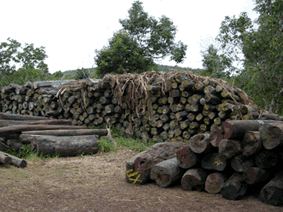Stocks de bois précieux de Madagascar – quelle voie emprunter ?
DOI:
https://doi.org/10.4314/mcd.v6i2.8Keywords:
rosewood, natural ressources, stocks, governance, bois de rose, ressources naturelles, gouvernance, gestion de stocks, CITES, TRAFFIC, ivory, rhino, illegal logging, exploitation forestière illégale, ivoire, éléphant, rhinocérosAbstract
Après avoir culminé en 2009 et 2010, l’exploitation de bois de rose a ralenti suite à une interdiction d’exportation adoptée par le gouvernement de transition de Madagascar (HAT) en réponse à la pression internationale croissante se référant au trafic illégal de bois de rose causant la destruction des forêts officiellement protégées. Le principal de ces bois précieux illégaux était destiné à la Chine. À la suite de l’interdiction d’exportation, un volume conséquent de bois de rose est à présent stocké dans les villages et les ports le long de la côte nord-est de Madagascar, sachant cependant que le volume exact n’est pas bien défini dans la mesure où l’inventaire est en cours et que le processus ouvre ainsi la possibilité d’ajouter de nouveaux bois fraîchement exploités aux stocks anciens. Cela signifie qu'il n’existe pour le moment aucune estimation précise du volume de bois précieux exploités sous un permis (et à l’extérieur des limites des aires protégées) ou de manière illégale à l’intérieur des limites des aires protégées.
Le 25 août 2011 une réunion se déroulant dans la région SAVA entre les représentants de la HAT et les trafiquants de bois de rose a révélé que le gouvernement voulait mettre un terme au trafic illégal et n’autorisait donc plus aucune exportation de bois de rose. Dans un avis du 12 juillet 2011, l’UNESCO a proposé d’éliminer tous les stocks dans un délai de 12 à 18 mois suivant leur saisie ; entre temps, la Banque mondiale cherchait comment vendre ces stocks de bois illégaux de façon responsable et transparente afin de financer les efforts destinés à protéger la biodiversité des forêts humides de Madagascar. À ce stade, on ne sait pas comment la HAT va gérer ce stock de bois précieux.
Le journal MCD observe le processus et voudrait donner la parole à quelques experts et praticiens impliqués dans cette crise du bois de rose.
Madagascar’s rosewood stocks – which way to go?
After peaking in 2009 and 2010, rosewood logging has slowed due to an export ban enacted by Madagascar's transitional government (HAT) in response to growing international pressure over the illegal traffic of rosewood causing the degradation of the country’s formally protected forests. Most of the illegally sourced rosewood was destined for China. As a consequence of the export ban much of the rosewood is now sitting in villages and ports along the northeastern coast of Madagascar, and it is not clear how much of the rosewood stock has been inventoried by authorities given that it is an ongoing process, leaving open the possibility that newly-logged wood is being added to stockpiles. This means that currently there is no clear picture of how much of the rosewood is been harvested with permits (i.e., from outside protected areas) or illegally from within protected areas.
On 25 August 25 2011 a meeting in the SAVA region between HAT representatives and the rosewood traffickers revealed that the government wants to stop the illegal traffic and consequently will not allow any further exportation of rosewood. In a paper issued on 12 July, UNESCO proposed to eliminate all of the stocks within 12-18 months of the seizure of the wood; in the meantime, the World Bank is exploring a way to responsibly and transparently sell illegal timber stockpiles as a means to finance efforts for conserving Madagascar’s rainforest biodiversity. At this point, it is not clear how the HAT may deal with the stocked rosewood.
The journal MCD is observing this process and would like to give voice to some of the experts and practitioners involved in this rosewood crisis.

Downloads
Additional Files
Published
Issue
Section
License
All journal content, except where otherwise noted, is licensed under a creative common Attribution 4.0 International and is published here by the Indian Ocean e-Ink under license from the author(s).


